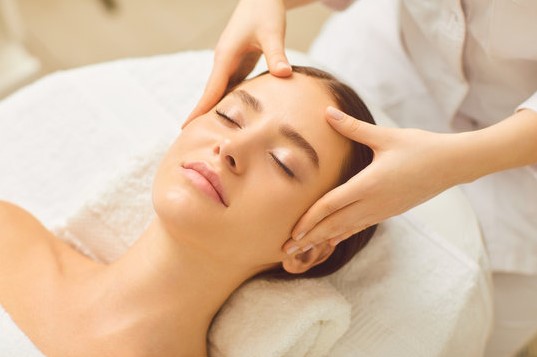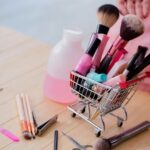Facial tools are specialized devices designed for use on the face and neck area to enhance skincare routines and promote overall skin health. These tools come in various shapes, materials, and designs, each serving a specific purpose. Some common types of facial tools include facial rollers, gua sha tools, facial massage tools, and microneedling devices.
Facial rollers are handheld tools with a rolling mechanism and a handle. They are typically made of materials like jade, rose quartz, or stainless steel. When rolled over the face, these tools help increase blood circulation, reduce puffiness, and promote lymphatic drainage, leading to a more radiant and youthful complexion.
Gua sha tools are flat, smooth stones or sculpted tools used for scraping and massaging the face. Traditionally crafted from materials like jade or rose quartz, gua sha tools are believed to improve circulation, reduce tension, and promote lymphatic drainage, resulting in a more sculpted and contoured appearance.
Facial massage tools come in various shapes and designs, such as vibrating wands, sculpting bars, or specialized massage heads. These tools are used to apply targeted pressure and massage techniques to the face, neck, and jawline, helping to relieve muscle tension, improve circulation, and promote a more toned and lifted appearance.
Microneedling tools, also known as derma rollers or dermastamps, are devices with tiny needles that create controlled micro-injuries on the skin’s surface. This process stimulates the body’s natural healing response, promoting collagen production and improving skin texture, fine lines, and overall complexion.
Using facial tools can offer numerous benefits, including improved circulation, lymphatic drainage, reduced puffiness and tension, enhanced product absorption, and a more sculpted and radiant appearance. However, it’s essential to follow proper techniques, use high-quality tools, and consult with a professional if needed to ensure safe and effective use.
Table of Contents
Facial Rollers
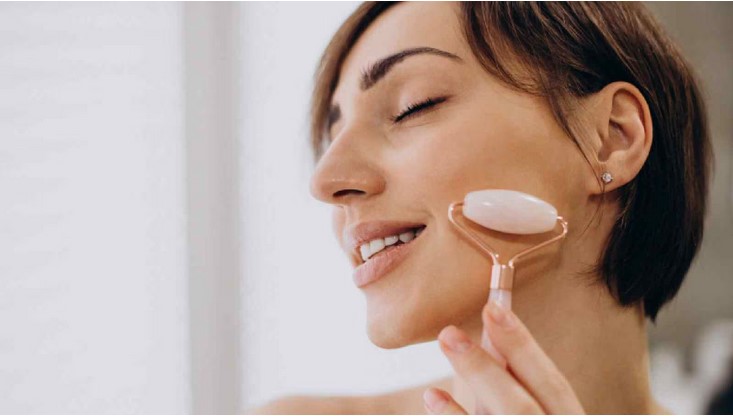
Facial rollers are handheld tools designed to massage and stimulate the facial muscles and skin. These tools typically feature a handle attached to a rolling head made of various materials, such as jade, rose quartz, or stainless steel. The use of facial rollers has gained popularity in recent years due to their purported benefits for improving skin health and promoting a more youthful appearance.
One of the most common materials used for facial rollers is jade. Jade rollers are prized for their cooling properties, which can help reduce puffiness and inflammation when rolled over the face. Rose quartz rollers, on the other hand, are believed to have a calming and soothing effect, making them a popular choice for those seeking a relaxing facial massage experience.
The benefits of using facial rollers are numerous. Regular use is said to improve blood circulation, which can help promote a radiant, glowing complexion. Facial rollers can also aid in lymphatic drainage, reducing puffiness and fluid retention in the face. Additionally, the gentle massage provided by the rollers can help to relax facial muscles, potentially diminishing the appearance of fine lines and wrinkles over time.
To use a facial roller effectively, start by cleansing your face and applying a facial oil or serum to allow the roller to glide smoothly over your skin. Begin rolling outward from the center of your face, working in upward motions along the contours of your face. Pay special attention to areas prone to puffiness, such as under the eyes and along the jawline. Gentle pressure should be applied, but avoid excessive force, which can cause discomfort or damage to the delicate facial skin.
Facial rollers can be a valuable addition to your skincare routine, providing a relaxing massage experience and potentially enhancing the absorption of your favorite skincare products. However, it’s essential to choose high-quality rollers made from non-porous materials and to clean them regularly to maintain hygiene and prevent the spread of bacteria.
Gua Sha Tools
Gua sha is an ancient Chinese practice that involves using a flat, smooth tool to gently scrape the skin in upward strokes. This technique is believed to improve circulation, reduce inflammation, and promote lymphatic drainage. Gua sha tools are typically made from natural materials like jade, rose quartz, or stainless steel.
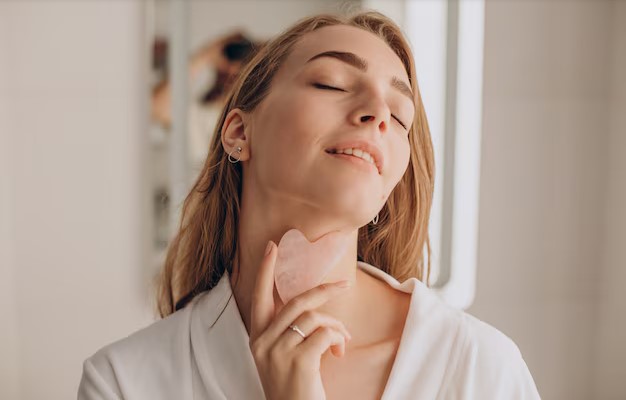
Benefits of Gua Sha
- Improves blood circulation and lymphatic drainage
- Reduces puffiness and inflammation
- Promotes collagen production for a more youthful appearance
- Relieves muscle tension and tightness
- Enhances the absorption of skincare products
Types of Gua Sha Tools
- Jade Gua Sha: Jade is a popular choice for gua sha tools due to its cooling properties and believed ability to promote energy flow.
- Rose Quartz Gua Sha: Rose quartz is a gentle stone known for its calming and soothing effects on the skin.
- Stainless Steel Gua Sha: Stainless steel gua sha tools are durable, easy to clean, and often more affordable than gemstone options.
- Contoured Gua Sha: These tools feature curved edges and contours designed to fit specific areas of the face, such as the jawline or under-eye area.
How to Use Gua Sha Tools
- Start with a clean, moisturized face and apply a facial oil or serum to create a smooth gliding surface.
- Hold the gua sha tool at a 15-30 degree angle against your skin, applying gentle pressure.
- Use upward strokes, following the contours of your face, and work in sections (e.g., forehead, cheeks, jawline).
- Repeat each stroke 3-5 times, using gentle pressure and avoiding dragging or tugging the skin.
- Finish by gently tapping the tool on your face to promote lymphatic drainage and product absorption.
Remember to clean your gua sha tool after each use and store it properly to maintain its effectiveness and longevity.
Facial Massage Tools
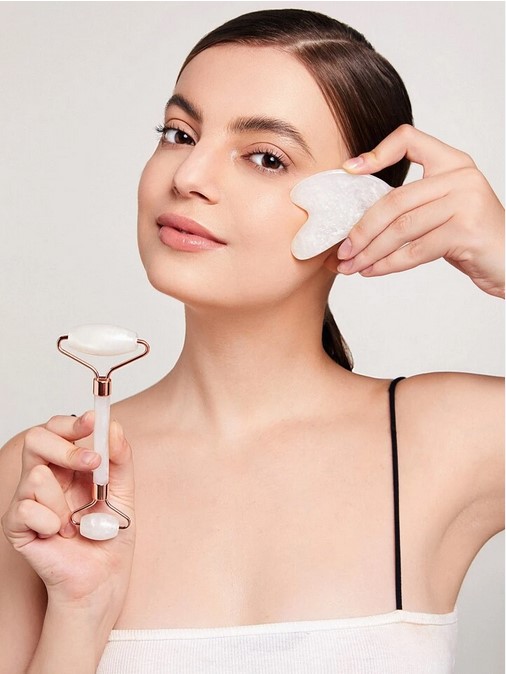
Facial massage tools are designed to provide a rejuvenating massage to the face, promoting circulation, lymphatic drainage, and relaxation of facial muscles. These tools come in various forms, including manual and vibrating options, each offering unique benefits.
Types of Facial Massage Tools
Manual Facial Massage Tools:
- Jade Rollers: These smooth, cool stones roll over the face, helping to depuff, improve circulation, and provide a calming massage.
- Gua Sha Tools: Traditionally used in Chinese medicine, these flat, sculpted tools are used to gently scrape and massage the face, promoting lymphatic drainage and releasing tension.
- Facial Massagers: Handheld tools with nodules or ridges that allow for targeted massage and acupressure on specific areas of the face.
Vibrating Facial Massage Tools:
- Facial Massagers: Electric or battery-powered devices that deliver vibrations to the face, enhancing circulation and relaxing facial muscles.
- Microcurrent Devices: These tools use low-level electrical currents to stimulate facial muscles, promoting a lifted and toned appearance.
Benefits of Facial Massage
- Improves circulation and lymphatic drainage, reducing puffiness and promoting a healthy glow.
- Relieves tension and stress in facial muscles, potentially minimizing the appearance of fine lines and wrinkles.
- Enhances the absorption of skincare products by increasing blood flow to the face.
- Promotes relaxation and a sense of well-being through the gentle, soothing motions.
- Helps to sculpt and contour the face by toning and lifting facial muscles.
How to Use Facial Massage Tools
- Cleanse and prepare the skin by applying a facial oil or serum to allow for smooth gliding of the tool.
- Follow the recommended massage techniques and patterns for the specific tool, typically starting from the center of the face and working outwards.
- Apply gentle pressure, avoiding excessive force or dragging of the skin.
- Focus on areas of tension or concern, such as the jawline, forehead, or under-eye region.
- Incorporate upward and outward motions to encourage lymphatic drainage and a lifted appearance.
- Use the tools consistently, following the manufacturer’s instructions for optimal results.
Facial massage tools offer a convenient and enjoyable way to incorporate facial massage into your skincare routine, promoting relaxation, improved circulation, and a revitalized complexion.
Microneedling Tools
Microneedling is a skincare technique that involves using a tool with tiny needles to create microscopic punctures in the skin. This controlled injury triggers the body’s natural healing process, stimulating collagen and elastin production, which can improve the appearance of fine lines, wrinkles, acne scars, and hyperpigmentation.
Benefits of Microneedling:
- Reduces the appearance of fine lines and wrinkles
- Minimizes acne scars and hyperpigmentation
- Improves skin texture and tone
- Enhances product absorption
- Boosts collagen and elastin production
Types of Microneedling Tools:
- Derma Rollers: These handheld tools feature a cylindrical body with hundreds of tiny needles protruding from the surface. They are rolled over the skin, creating micro-punctures.
- Derma Pens/Stamps: These pen-like devices have a cartridge with microneedles that vertically stamp the skin, providing more precise treatment.
- Derma Discs: Similar to derma rollers, these tools have a flat surface with microneedles arranged in a circular pattern.
How to Use Microneedling Tools Safely:
- Cleanse the skin thoroughly before use.
- Sterilize the tool according to the manufacturer’s instructions.
- Apply a numbing cream if desired, to minimize discomfort.
- Use gentle pressure and roll or stamp the tool in different directions, avoiding sensitive areas like the eyes.
- Follow up with a serum or moisturizer to aid absorption and hydration.
- Disinfect the tool after use and store it properly.
- Start with shorter needle lengths (0.25-0.5 mm) and gradually increase as your skin becomes accustomed.
- Avoid microneedling on active acne, open wounds, or sunburned skin.
- Consult a professional for guidance, especially for deeper needle lengths or specific skin concerns.
Microneedling tools can be an effective addition to your skincare routine, but it’s crucial to use them safely and responsibly to avoid potential complications.
Cleaning and Maintenance
Proper cleaning and maintenance of facial tools are crucial for ensuring their longevity and preventing the spread of bacteria or other contaminants that could lead to skin irritation or breakouts. Different materials require different cleaning methods, so it’s essential to follow the manufacturer’s instructions or general guidelines for each tool.
For facial rollers and gua sha tools made of stone or metal, regular cleaning with a mild soap and warm water is recommended. Avoid using harsh chemicals or abrasives that could damage the surface of the tool. After cleaning, thoroughly dry the tool with a clean, soft cloth to prevent moisture from harboring bacteria.
Facial massage tools made of silicone or plastic can be cleaned with soap and water or a gentle antibacterial solution. Ensure to rinse them thoroughly and allow them to air dry completely before storing them.
Microneedling tools require extra care and attention when it comes to cleaning and maintenance. After each use, they should be thoroughly disinfected with a solution specifically designed for medical-grade tools. Proper sterilization is essential to prevent the spread of infections or skin irritations.
It’s also important to store facial tools in a clean, dry place, away from moisture and contaminants. Consider investing in a dedicated storage case or pouch to keep them protected and organized.
Regular cleaning and maintenance not only extend the lifespan of your facial tools but also ensure a hygienic and safe experience for your skin. Neglecting proper cleaning can lead to the buildup of dirt, oils, and bacteria, which can counteract the benefits of using these tools and potentially cause skin issues.
Safety Precautions
When using facial tools at home, it’s crucial to prioritize safety and take necessary precautions to avoid potential risks and side effects. Improper use or neglecting proper hygiene can lead to skin irritation, inflammation, or even infection.
Potential Risks and Side Effects:
- Microtears or abrasions on the skin, especially with aggressive techniques or excessive pressure
- Spreading of bacteria or infections if tools are not properly sanitized
- Exacerbation of existing skin conditions like acne, rosacea, or eczema
- Bruising or broken capillaries, particularly with tools like jade rollers or gua sha stones
Precautions for Different Skin Types and Conditions:
- Sensitive Skin: Avoid aggressive techniques and use tools gently. Start with shorter durations and less pressure.
- Acne-Prone Skin: Sanitize tools thoroughly before and after use to prevent spreading bacteria.
- Rosacea: Avoid excessive rubbing or pressure, as it may worsen redness and inflammation.
- Open Wounds or Active Breakouts: Avoid using tools directly on affected areas to prevent further irritation or spread of infection.
When to Avoid Using Certain Tools:
- Sunburned or Severely Irritated Skin: Refrain from using facial tools until the skin has fully healed.
- After Cosmetic Procedures: Consult with your dermatologist or aesthetician before using any facial tools, as they may disrupt the healing process or cause complications.
- Certain Medications: Some medications, such as retinoids or blood thinners, may increase skin sensitivity or risk of bruising. Consult with your healthcare provider before using facial tools.
Remember, facial tools should be used with caution and moderation. If you experience any adverse reactions, discontinue use immediately and consult a dermatologist or skincare professional.
Incorporating Facial Tools into Skincare Routine
Facial tools can be seamlessly integrated into your existing skincare routine for enhanced benefits. Here’s how you can incorporate them for optimal results:
Daily Routine
- Start with a freshly cleansed face. Facial tools work best on clean skin.
- Apply your favorite serum or facial oil before using the tool. The massage action will help the products absorb better.
- Use a facial roller or gua sha tool for 5-10 minutes, following the recommended techniques and motions.
- Follow up with your regular moisturizer or any other skincare products you typically use.
Weekly Routine
- Once or twice a week, use microneedling tools before applying your serum or treatment products. The micro-channels created will enhance absorption.
- On the same day, follow up with a hydrating sheet mask or a nourishing overnight mask after using your facial tools.
Tips for Best Results
- Be gentle and avoid excessive pressure or aggressive motions, especially around the delicate eye area.
- Use upward and outward strokes to promote lymphatic drainage and improve circulation.
- For facial rollers, keep the tool in constant motion and avoid tugging or pulling the skin.
- With gua sha tools, use the flat side for larger areas and the curved edges for more targeted areas like the jawline or under-eye region.
- Always cleanse your facial tools after each use and follow the recommended sanitization methods.
- Consistency is key. Regular use of facial tools, combined with a good skincare routine, will yield the best results over time.
By incorporating facial tools into your daily and weekly skincare regimen, you can enhance the efficacy of your products, promote better absorption, and enjoy a revitalized, glowing complexion.
Choosing the Right Facial Tool
Selecting the right facial tool is crucial for achieving desired results and avoiding potential skin irritation or damage. Here are some key factors to consider when choosing facial tools:
Skin Type and Concerns: Different tools are designed to target specific skin concerns. For example, jade rollers and gua sha tools are great for promoting lymphatic drainage and reducing puffiness, while microneedling tools can help with fine lines, scarring, and uneven skin texture. If you have sensitive skin, opt for gentler tools like rollers or massage tools.
Budget: Facial tools can range from affordable drugstore options to high-end luxury brands. Determine your budget and prioritize quality over cost when possible. Investing in a well-made tool can ensure longevity and better results.
Material: Facial tools are commonly made from materials like jade, rose quartz, stainless steel, or silicone. Each material has its own benefits and properties. For example, jade and rose quartz are known for their cooling and soothing effects, while stainless steel is durable and easy to clean.
Brand Reputation and Reviews: Research reputable brands and read customer reviews before purchasing facial tools. Look for brands that prioritize quality, safety, and customer satisfaction.
Popular and Recommended Brands:
- Mount Lai: Known for their high-quality jade and rose quartz facial tools, Mount Lai offers a range of rollers, gua sha tools, and massage tools.
- Nurse Jamie: Founded by an aesthetician, Nurse Jamie offers microneedling tools and other skincare devices designed for at-home use.
- Skin Gym: This brand specializes in facial massage tools, including gua sha tools and sculpting tools made from various materials like rose quartz and stainless steel.
- Herbivore Botanicals: In addition to their natural skincare products, Herbivore Botanicals offers a range of facial tools, including jade rollers and gua sha tools.
- Roselyn Boutique: This brand is known for their affordable yet high-quality facial rollers, gua sha tools, and other facial tools made from various materials.
Remember, the right facial tool should align with your specific skin concerns, budget, and preferences. Don’t hesitate to consult with a skincare professional or do thorough research to find the best tool for your needs.
DIY Facial Tools
For those looking to explore the world of facial tools without a significant investment, DIY options can be an appealing choice. With a bit of creativity and the right materials, you can craft your own facial rollers, gua sha tools, and even microneedling devices at home. However, it’s essential to exercise caution and follow proper safety guidelines when making and using these tools.
Facial Rollers
One of the simplest DIY facial tools is a roller. You can repurpose a small, cylindrical object like a jade or rose quartz stone, or even a clean, empty glass bottle. Simply wrap the cylinder in a soft, clean cloth or paper towel and roll it gently over your face in an upward and outward motion.
Gua Sha Tools
Gua sha tools can be crafted from smooth, flat stones or even the back of a spoon. Look for materials with a curved edge and a polished surface. Clean and disinfect the tool thoroughly before use, and always apply a facial oil or serum to create a gliding motion over the skin.
Microneedling Tools
While microneedling tools can be more challenging to make at home, it’s possible to create a basic device using a clean, sterilized needle or a derma roller. However, it’s crucial to exercise extreme caution and follow strict sterilization protocols to prevent infection or injury.
Materials Needed
Depending on the tool you’re making, you may need materials like smooth stones, empty glass bottles, clean needles or derma rollers, soft cloths or paper towels, and facial oils or serums.
Instructions
- Gather your materials and ensure they are clean and disinfected.
- Assemble the tool according to your chosen design (e.g., wrapping a stone in a cloth or securing a needle to a handle).
- Test the tool on a small area of skin first to check for any adverse reactions.
- Use the tool gently, following the recommended techniques and motions for your specific tool.
- Clean and disinfect the tool thoroughly after each use.
Pros and Cons of DIY Tools
Pros:
- Cost-effective
- Customizable
- Encourages creativity and experimentation
Cons:
- Potential for improper sterilization or use, leading to infections or injury
- Lack of professional guidance or quality control
- May not be as effective or durable as professionally manufactured tools
While DIY facial tools can be a fun and affordable option, it’s essential to prioritize safety and proceed with caution. If you have any concerns or experience adverse reactions, it’s best to consult a professional aesthetician or dermatologist.
Professional vs. At-Home Use
While at-home facial tools can be a convenient and cost-effective way to incorporate facial massage and skincare techniques into your routine, there are significant differences between professional and at-home tools. Professional tools are typically more powerful, durable, and effective, designed for use by trained aestheticians and dermatologists.
Professional facial tools are often made with high-quality materials, such as surgical-grade stainless steel or medical-grade silicone, ensuring they are hygienic, long-lasting, and capable of withstanding rigorous use. These tools are also designed to target specific areas and concerns more effectively, such as deep-tissue massage, lymphatic drainage, or advanced microneedling techniques.
In contrast, at-home facial tools are generally less powerful and designed for gentler, more superficial use. While they can provide benefits like improved circulation, lymphatic drainage, and a temporary lifting effect, they may not be as effective for addressing more significant concerns like deep wrinkles, scarring, or severe acne.
It’s important to note that certain treatments, such as microneedling or chemical peels, should only be performed by licensed professionals in a controlled environment. At-home versions of these tools may not be as effective or safe, and improper use can lead to skin irritation, infection, or other adverse effects.
While at-home facial tools can be a great addition to your skincare routine, it’s essential to understand their limitations and when to seek professional treatment. If you have significant skin concerns, such as severe acne, hyperpigmentation, or signs of aging, it’s best to consult with a dermatologist or licensed aesthetician for professional treatment and guidance.

